Indus Valley Civilization | General Awareness - Bank Exams PDF Download
| Table of contents |

|
| Indus Valley Civilisation |

|
| Date of Indus Valley Civilisation |

|
| Important sites of Indus Valley Civilisation |

|
| Salient Features of the Indus Valley Civilisation |

|
| Conclusion |

|
The Indus Valley Civilization, also called the Indus Civilization, existed in the northern regions of South Asia during the Bronze Age from 3300 BCE to 1300 BCE, reaching its peak between 2600 BCE and 1900 BCE. It was among the earliest civilizations in the Near East and South Asia, alongside ancient Egypt and Mesopotamia. Out of these, it was the most extensive, with archaeological sites spreading across a vast region from present-day northeast Afghanistan, through much of Pakistan, and into western and northwestern India.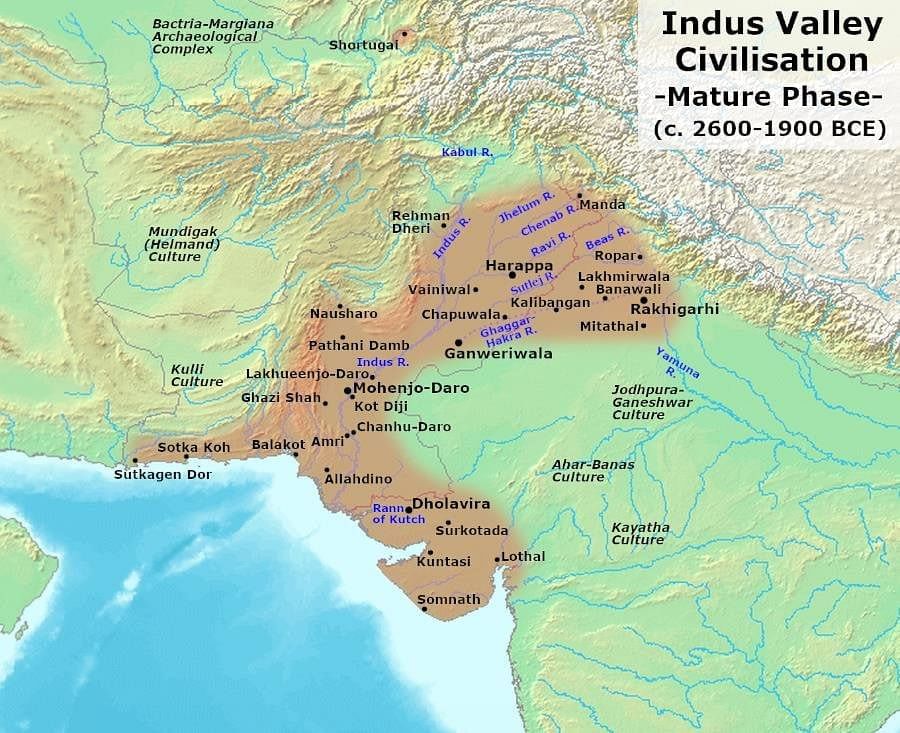
Indus Valley Civilisation
- The rise of the Indus Valley Civilization (IVC), also called the Harappan Civilization, signifies the start of Indian history.
- The Indus Valley Civilisation got its name from the Indus river system, where the initial sites of the civilization were found and excavated.
- Commencing around 3300 BC, the Indus Valley Civilization prospered between 2600 and 1900 BC (known as the Mature Indus Valley Civilization). Its decline began circa 1900 BC and it vanished by 1400 BC.
- Also referred to as the Harappan Civilization, named after the first uncovered city, Harappa in Punjab, Pakistan.
- The earliest proof of cotton cultivation was unearthed in Mehrgarh, Pakistan, tracing back to the Pre-Harappan civilization.
- The Indus Valley hosted one of the most extensive ancient urban civilizations alongside Egypt, Mesopotamia, India, and China.
- In the 1920s, the Archaeological Department of India conducted excavations in the Indus Valley, revealing the remnants of two ancient towns, Mohenjodaro and Harappa.
- In 1924, the ASI Director-General John Marshall announced the discovery of a new civilization in the Indus Valley to the world.

Date of Indus Valley Civilisation
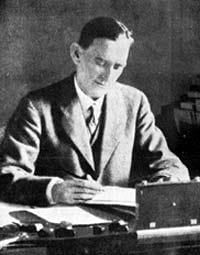
- Sir John Marshall estimated the time Mohenjodaro was built to be between 3250 and 2750 B.C. back in 1931.
- As more sites are discovered, the timeline of the Harappan civilization is updated.
- The invention of radiocarbon dating allows for more precise dating.
- Using radiocarbon dating, Fairservis revised the timeline of the Harappan civilization to be from 2000 to 1500 B.C. by 1956.
- In 1964, D.P. Agarwal suggested that the entire duration of this civilization should be from 2300 to 1750 B.C.
- However, these dates might change in the future.
Important sites of Indus Valley Civilisation
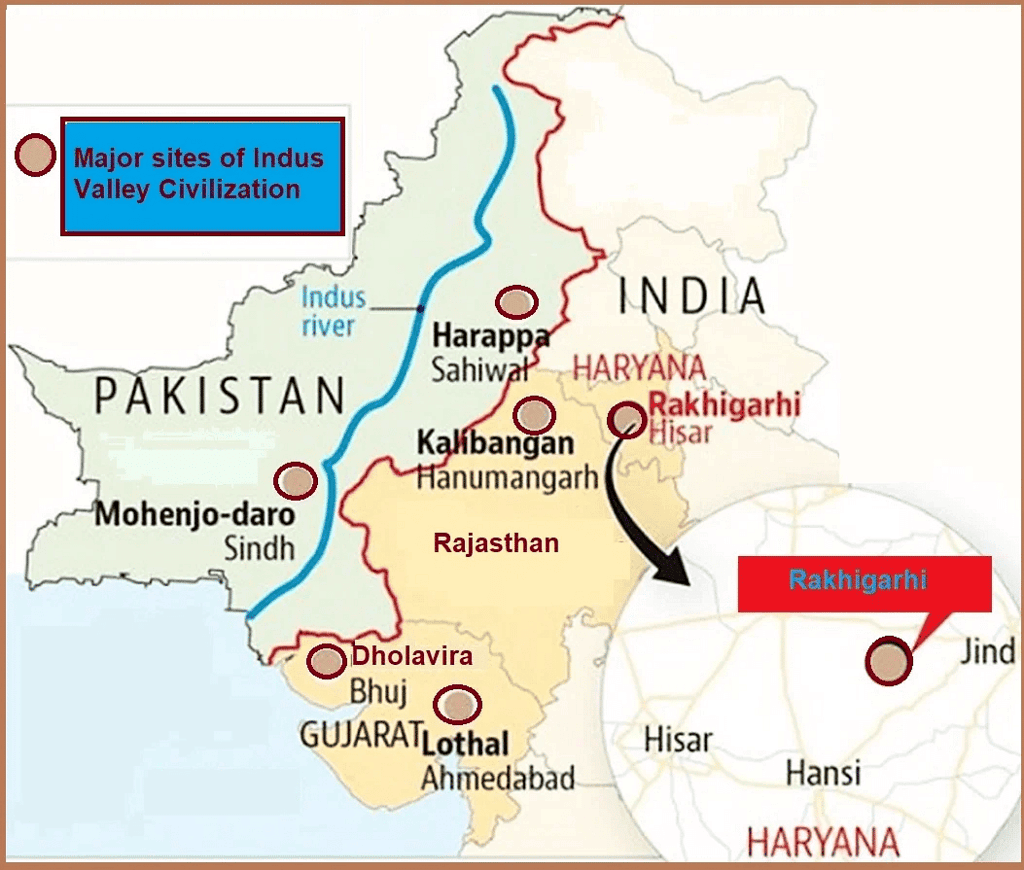
- Harappa
- Discovered by: Marshall, Rai Bahadur Daya Ram Sahni, and Madho Sarup Vats in 1921
- Location: Montgomery district of Punjab, on the banks of the Ravi River
- Features: Granaries, bullock carts, sandstone human anatomy sculptures
- Mohenjo-daro
- Discovered by: R.D. Banerjee, E. J. H. MacKay, and Marshall in 1922
- Location: Larkana district, Punjab, on the banks of the Indus River
- Features: Mound of the Dead, Great Bath, Bronze dancing girl, Seal of Pashupati Mahadeva statue, Steatite of bearded man, Numerous seals, Agricultural innovation with early cotton cultivation, Domesticated animals including sheep, goats, and pigs
- Sutkagendor
- Discovered by: Stein in 1929
- Location: Dast river in Pakistan's southern Balochistan province
- Features: Trading post linking Harappa and Babylon
- Chanhudaro
- Discovered by: N.G. Majumdar in 1931
- Location: Sindh, on the Indus River
- Features: Shop with bead makers, Depiction of a dog chasing a cat's footprint
- Amri
- Discovered by: N.G. Majumdar in 1935
- Location: Banks of the Indus River
- Features: Evidence of antelope
- Kalibangan
- Discovered by: Ghose in 1953
- Location: Rajasthan, beside the Ghaggar River
- Features: Altar of fire, Camel bones, Wooden plough
- Lothal
- Discovered by: R. Rao in 1953
- Location: Gujarat, on the Bhogva river near Gulf of Cambay
- Features: First artificial port, Dockyard, Rice husk, Altars of fire
- Surkotada
- Discovered by: J.P. Joshi in 1964
- Location: Gujarat
- Features: Horse-like skeletons, Beads
- Banawali
- Discovered by: R.S. Bisht in 1974
- Location: Hisar district, Haryana
- Features: Beads, Barley evidence, Pre-Harappan and Harappan cultures
- Dholavira
- Discovered by: R.S. Bisht in 1985
- Location: Gujarat, Rann of Kachchh
- Features: Water collection system, Reservoir
Salient Features of the Indus Valley Civilisation
Town Planning
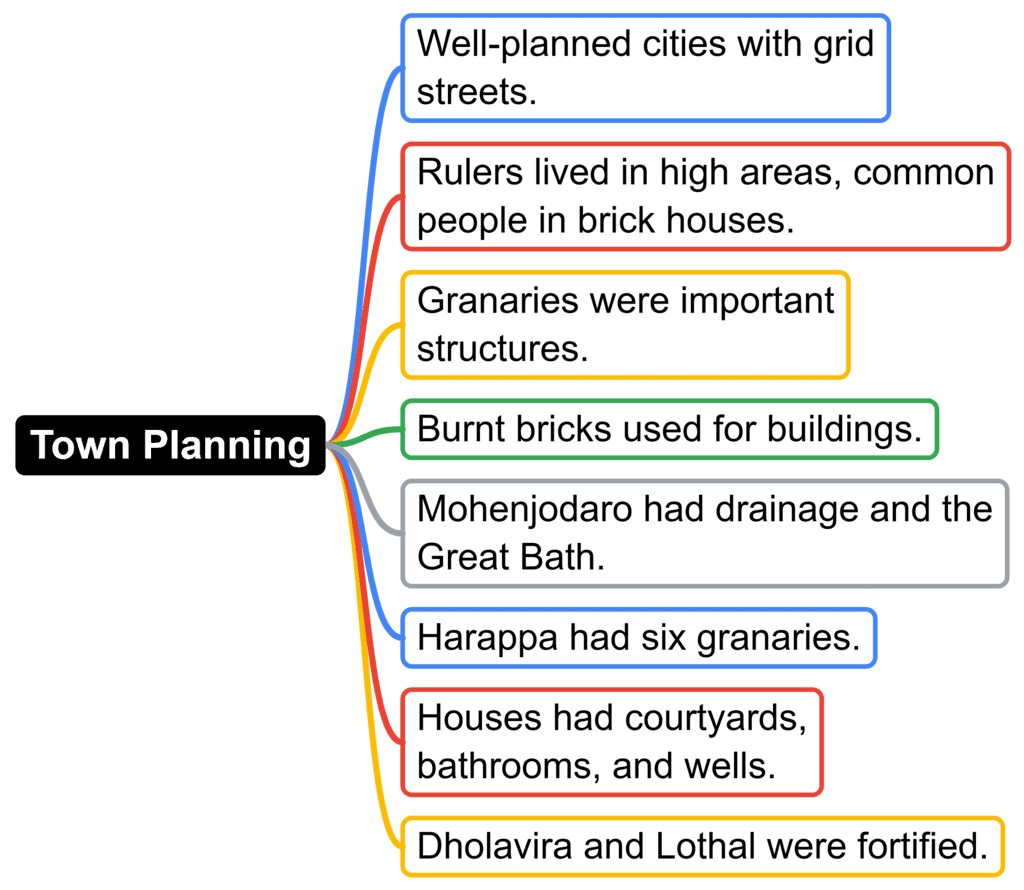
Economic Life
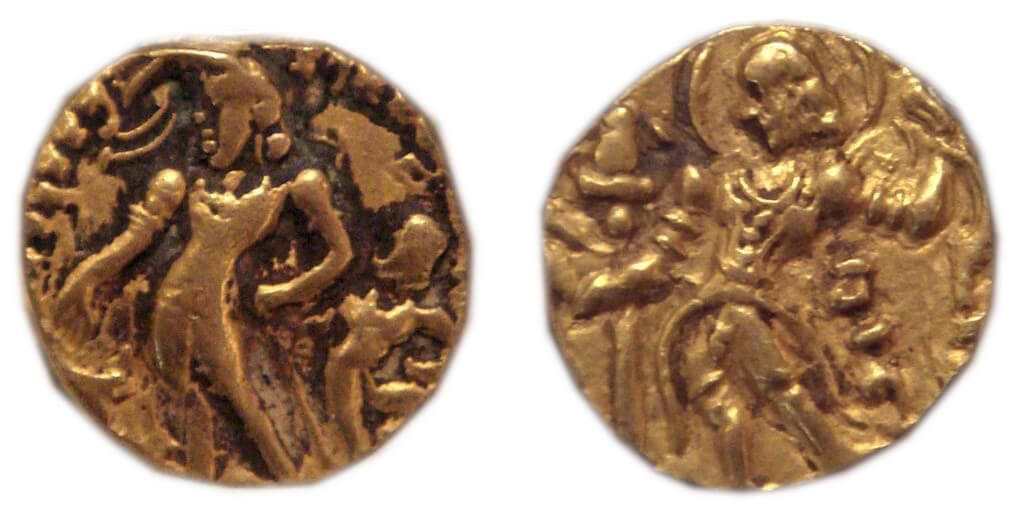
- The Indus people valued trade, as shown by their use of various seals, a common writing system, and standardized weights and measures.
- Harappans traded a variety of materials like stone, metal, and shell extensively.
- Instead of using metal coins, they exchanged goods through barter.
- They navigated the shores of the Arabian Sea for trade.
- Establishing a trading outpost in northern Afghanistan facilitated commerce with Central Asia.
- Trade connections extended to regions near the Tigris and Euphrates rivers.
- Harappans engaged in long-distance trade of lapis lazuli, potentially enhancing the status of the ruling elite.
Agriculture
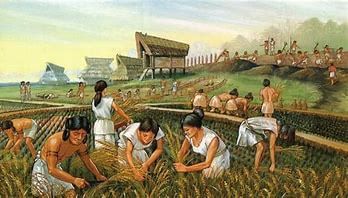
- Harappan communities mostly settled in river plains and grew various food crops.
- Crops like wheat, barley, rai, peas, sesame, lentil, chickpea, and mustard were commonly cultivated.
- Millets were also found in Gujarat, while rice was not as commonly used.
- The Indus people were the first to start cotton farming.
- Discoveries of whole grains hint at agriculture, but fully understanding their farming methods is a challenge.
- Depictions on seals and terracotta art suggest the use of bulls and oxen for ploughing.
- Most Harappan sites were in semi-arid regions where irrigation was likely needed.
- Traces of canals have been found in the Shortughai Harappan site in Afghanistan, but not in Punjab or Sindh.
- Harappans, besides farming, also practiced large-scale animal husbandry.
- Faint traces of horses have been found in Mohenjodaro and a questionable ceramic piece in Lothal, indicating some horse presence.
- However, horses did not play a central role in Harappan civilization.
Social Life
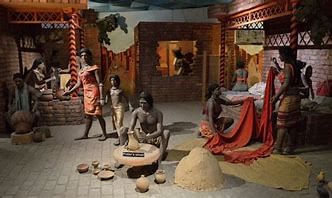
- Both men and women in the Harappan society wore two pieces of cloth - one for the top and one for the bottom.
- Both genders adorned themselves with beads.
- Women wore various ornaments like bangles, bracelets, fillets, girdles, anklets, ear-rings, and finger rings.
- Decorations were crafted from gold, silver, copper, bronze, and semi-precious stones.
- The use of cosmetics was common. Objects made of pottery, stone, shells, ivory, and metal were found at Mohenjodaro.
- Copper was utilized for spindles, needles, combs, fish hooks, and knives.
- Fishing, bullfighting, and hunting were popular activities.
- Weapons like axes, spearheads, daggers, bows, and arrows were made of copper and bronze.
Social Institutions
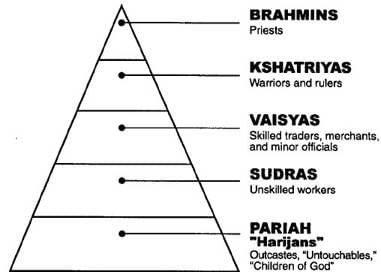
- In the ancient Indus valley, only a few written things have been found, and scholars are still trying to understand the Indus script.
- Figuring out the type of state and organizations that existed in the Indus Valley Civilization is difficult because there are not many clues.
- No temples have been unearthed at any Harappan site. This means that it is unlikely that priests were in charge at Harappa.
- It is probable that a group of merchants held power in Harappa.
- When searching for a central authority or depictions of influential individuals, archaeological records may not offer clear answers.
- Some experts think that in Harappan society, there were no leaders and everyone was treated equally.
Art and Crafts
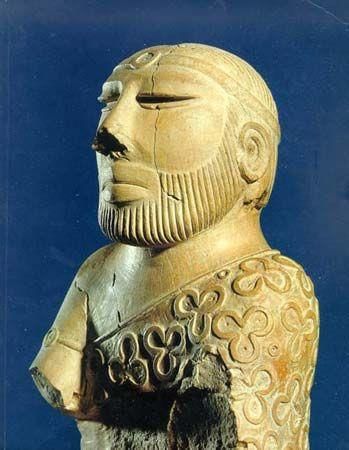
- The Harappans were skilled in making and using bronze.
- They got copper from mines in Rajasthan's Khetri area, and they probably got tin from Afghanistan.
- People found many objects with marks from textiles.
- Big structures made of bricks show that laying bricks was an important skill. This also tells us that there were people who specialized in stonework.
- The Harappans were good at making boats, beads, and seals. They were also good at making things from baked clay.
- Goldsmiths made jewelry from silver, gold, and precious stones.
- They used a potter's wheel to make their own shiny and smooth pottery.
Religion
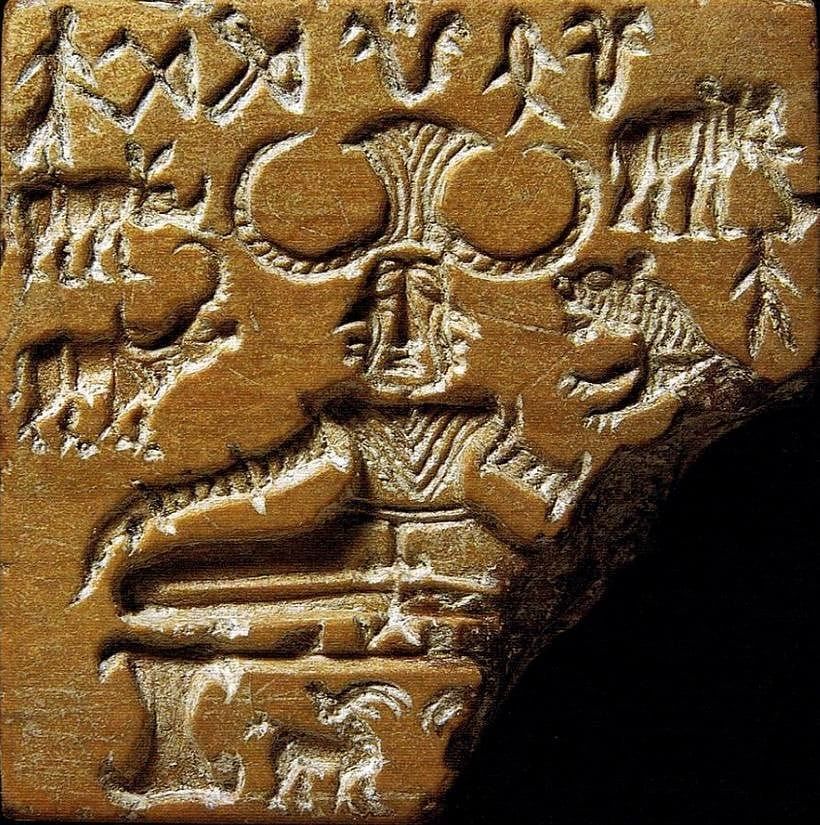
- Several clay figures of women found at Harappa. A plant grows from a woman's body in one figure.
- The Harappans viewed the earth as a fertility goddess, honoring her similar to how the Egyptians worshipped the Nile goddess Isis.
- The male deity depicted as a seal with three horned heads in a yogi posture.
- This deity sits on a throne surrounded by elephants, tigers, rhinoceroses, and buffalo. Two deer stand at his feet. The deity is known as Pushupati Mahadeva.
- Stone phallus and female sex organ symbols have been found.
- Trees and animals were greatly respected by the Indus people.
- The one-horned unicorn, linked to the rhinoceros, holds great significance, while the humped bull is the second most important.
- Many amulets have also been unearthed.
Script
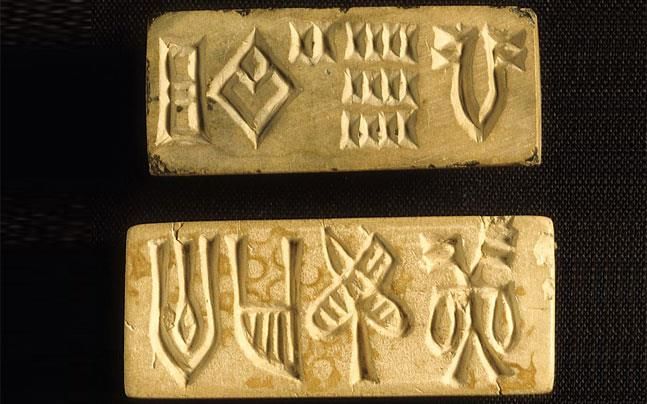
- The Harappan script is currently undergoing full deciphering.
- There are around 400 to 600 symbols, with 40 to 60 being essential and the others being variations.
- Most of the writing was done from right to left.
- On a few long seals, they used the boustrophedon method, which means writing in the opposite direction in alternating lines.
- According to Parpola and his colleagues from Scandinavia, Dravidian was the language of the Harappans. This belief is also held by some Soviet scholars.
- There are differing views among researchers concerning the Harappan and Brahmi scripts.
- The mystery of Harappan writing persists, and unraveling it is sure to yield fresh insights into this civilization.
Burial Methods
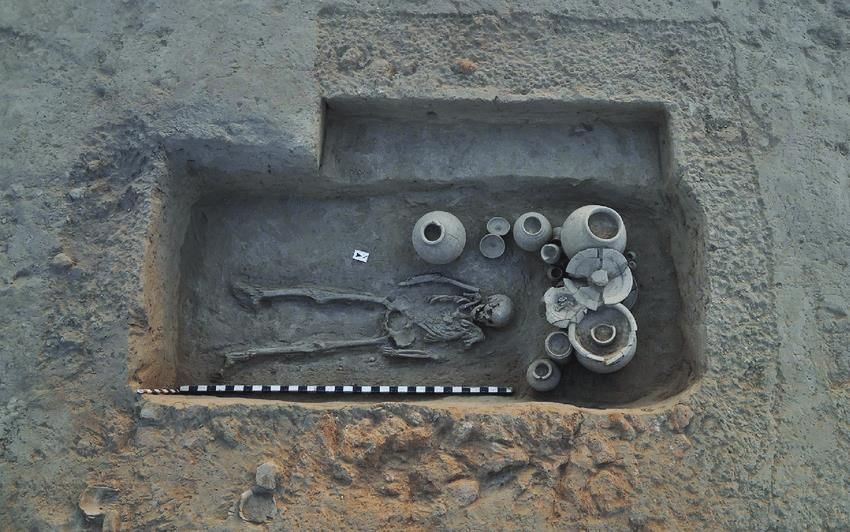
- Cemeteries found near towns like Mohenjodaro, Harappa, Kalibangan, Lothal, and Rupar provide insights into how the Harappans buried their dead.
- In Mohenjodaro, people were buried whole or after cremation.
- At Lothal, burial pits were lined with burned bricks, suggesting the use of coffins.
- In Harappa, wooden coffins were also found.
- In Lothal, some burials involved pots, sometimes with pairs of bones. However, there's no solid evidence of the practice of Sati.

Conclusion
The Indus civilization, also known as the Indus valley civilization or Harappan civilization, was the Indian subcontinent's first known urban culture. The civilisation appears to have existed between 2500 and 1700 BCE, however the southern sites may have continued into the second millennium BCE. The Indus civilization was the largest of the world's three early civilizations (the others being Mesopotamia and Egypt).
|
368 videos|749 docs|149 tests
|
FAQs on Indus Valley Civilization - General Awareness - Bank Exams
| 1. When did the Indus Valley Civilisation originate and evolve? |  |
| 2. What is the date of the Indus Valley Civilisation? |  |
| 3. What are some important sites of the Indus Valley Civilisation? |  |
| 4. What are the salient features of the Indus Valley Civilisation? |  |
| 5. Why is the Indus Valley Civilisation significant in history? |  |
















